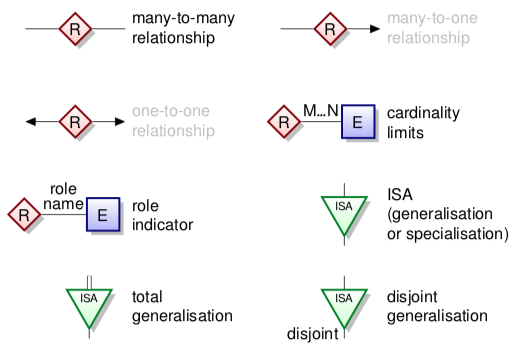Databases
Table of Contents
Database design: Conceptual models
Three phases:
- conceptual:
- what do we store
- how are the elements related to each other
- what are the constraints
- models: Entity/Relationship, UML
- logical:
- transform conceptual schema into the schema supported by the database
- models: relational model
- physical:
- design indices, table distribution, buffer sizes, etc.
- try to maximise performance of the final system
Conceptual models: Entity-Relationship & UML

static, models the structure and not operations. no methods or functions.
- rectangles represent entity sets
- ellipses represent attributes
- double line - multivalued attributes
- dashed line - derived attributes
- diamonds are relationship sets
- lines link attributes and relationship sets to entity sets
- underline indicates primary key attributes
Entity sets
entity is an abstract object (person, company, event..)
entitties have attributes (names, addresses, ...)
entity set is is a collection of similar entities (those sharing the same attributes).
represented by a set of attributes - descriptive properties possessed by all entities. the domain is set of permitted values for each attribute.
attribute types:
- simple and composite (e.g. street is composed of street name and number)
- number of values:
- single-valued: e.g. age of a person
- multivalued: e.g. person can have multiple phone numbers
- derived attributes:
- can be computed from other attributes
- e.g. age computed from date of birth
Weak entity sets
a weak entity set doesn't have a primary key. its existence depends on existence of an identifying entity set.
there has to be a total, one-to-may relationship set from identifying to weak entity set, shown by double diamond.
discriminator: a partial key, distinguishing weak entity only in combination with identifying entity. denoted by dashed underline.
primary key of weak entity set is combination of discriminator and primary key of identifying entity set.
Relationship sets
a relationship is association among several entities (a tuple (e₁, e₂, ...) of entities)
a relationship set is a set of relationship of same kind. i.e. a set of tuples (e₁, e₂, ...) where e₁ ∈ E₁, e₂ ∈ E₂, etc. Can have attributes.
example in UML with a relationship set plays-in and role indicators:

cardinality limits express number of entities to which another entity can be associated via relationship set:
- 0...1 means zero or one
- 1...1 means precisely one
- 0...* means any number
- 1...* means at least one
if cardinalities are not given, the default is many-to-many.
total participation: every entity in the entity set participates in at least one relationship in the relationship set
partial participation: entities may not participate in any relationship in the set
degree of a relationship set is number of entity sets participating in the relationship.
Is-a (inheritance)
lower-level entity sets are subgroups of the higher-level entity sets (e.g. an employee 'is a' person)

lower-level entity sets inherit all attributes and relationships of the higher-level entity sets
you can go top-down and find subgroups (specialisation) or bottom-up and combine entity sets (generalisation)
constraints:
- membership: value-based, assigns entity to subclass based on attribute values
- disjointness: an entity can belong to at most one subclass (default is overlapping, where it can belong to multiple)
- completeness: total specialisation, each superclass entity must belong to a subclass
Aggregation
treat relationship set as an abstract entity. allows relations between relations.
Summary


UML vs ER
attributes are shown within box of entity set, not as separate ellipses.
binary relationships are a line connecting entity sets, with name of relationship next to line.
if relationship set has attributes, name of relationship set is written in box along with attributes of relation; box is connected with dashed line to the relation line.
non-binary relationship sets are drawn with a diamond.
important differences:
- keys:
- ER supports keys with underlining
- UML has no standard for keys
- aggregation:
- ER: treating relationship set as entity
- UML: part-whole relation (non-exclusive composition)
- weak entities:
- ER: entities without own key
- UML: composition is similar, but says nothing about keys